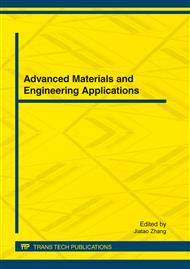[1]
R. S. Raghava, Role of matix-particle interface adhesion on fracture toughness of dual phase epoxy-polyethersulfone blend, J. Polym. Sci. Part B: Polym. Phys. 25(1987) 1017-1031.
DOI: 10.1002/polb.1987.090250504
Google Scholar
[2]
B. S. Kim, T. Chiba, T. Inoue, Morphology development via reaction-induced phase separation in epoxy / poly(ether sulfone) blends:morphology control using poly(ether sulfone) with functional end-groups, Polymer. 36 (1995) 43-47.
DOI: 10.1016/0032-3861(95)90673-p
Google Scholar
[3]
C. Girodet, E. Espuche, H.Sauterau, Influence of the addition of thermoplastic performed particles on the properties of an epoxy/anhydride network, J. Mater. Sci. 31(1996) 2997-3002
DOI: 10.1007/bf00356014
Google Scholar
[4]
R. J. Varley, J. H. Hodgkin, G. P. Simon, Toughening of a trifunctional epoxy system Part IV:Structure property relationships of the thermoplastic toughened system, Polymer. 42(2001) 3847-3858.
DOI: 10.1016/s0032-3861(00)00491-2
Google Scholar
[5]
S. J. Park, K. Li, F. L. Jin, Thermal stabilities and mechanical interfacial properties of polyethersulfone-modified epoxy resin, J. Industrial. Eng. Chem. 11(2005) 720- 725.
Google Scholar
[6]
B. Francis, S. Thomas, G. V. Asari, Synthesis of hydroxyl-terminated poly(ether ether ketone) with pendent tert-butyl groups and its use as a toughener for epoxy resins, J. Polym. Sci. Part B: Polym. Phys. 41(2006) 541-556.
DOI: 10.1002/polb.20713
Google Scholar
[7]
A. Saxena, B. Francis, V. Lakshmana, Toughening of an epoxy resin with hydroxyl-terminated poly (arylene ether nitrile) with pendent tertiary butyl groups, J. Appl. Polym. Sci. 106(2007) 1318-1331.
DOI: 10.1002/app.26356
Google Scholar
[8]
J. X. Song, G. Wu, J. J. Shi, G. X. Chen, Q. F. Li, Properties and morphology of interpenetrating polymer networks based on poly(urethane-imide) and epoxy resin. Macromolecular. Research. 18(2010) 944-950
DOI: 10.1007/s13233-010-1009-8
Google Scholar
[9]
Y. Z. Meng, A. S. Hay, X.G. Jian, S. C.Tjong, Synthesis of novel poly (phthalazinone ether sulfone ketone) s and improvement of their melt flow properties, J. Appl. Polym. Sci. 66 (1997), 1425-1432.
DOI: 10.1002/(sici)1097-4628(19971121)66:8<1425::aid-app1>3.0.co;2-g
Google Scholar
[10]
X.G. Jian, P.Chen, G. X. Liao, X. L. Zhu, S. H. Zhang, J. Y. Wang, Syntheses and properties of novel high performance series Poly(aromatic ethers) polymers containing phthalazinone moieties, Acta Polymerica Sinica. 4 (2003) 469-475.
DOI: 10.3724/sp.j.1105.2011.10207
Google Scholar
[11]
Y. J. Xu, S. K. Zhou, G. X. Liao, X. G. Jian, Curing kinetics of DGEBA epoxy resin modified by poly (phthalazinone ether ketone) (PPEK), Polymer-Plastic Technology and Engineering, in press.
DOI: 10.1080/03602559.2011.578294
Google Scholar
[12]
C.B. Bucknall, I.K. Partridge, Phase separation in epoxy resins containing polyethersulphone, Polymer. 24 (1983) 639-644.
DOI: 10.1016/0032-3861(83)90120-9
Google Scholar


